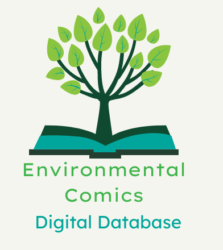Representations of Agency in Children’s and YA Environmental Comics
Many children’s and young adult comics depict empowered young protagonists who express concern for the environment and take action to help combat environmental issues, either individually or by collaborating with others. However, environmental comics can also perpetuate systemic issues of representations of age, gender, sexuality, social class, and race, leading to two important questions: Who gets to save the world in an environmental comic, and who gets left out of these narratives? To address these questions, the data visualizations below analyze the intersections of environmental themes and levels of youth environmental agency in over 70 children’s and YA comics from a variety of genres.
Visualizing Environmental Themes and Youth Agency
This chart visualizes the frequency of environmental themes in 80 children’s and young adult comics. Click the bubbles to view the titles and the protagonist’s level of environmental agency, or use the dropdown menu to filter by agency.
Breakdown of Environmental Themes by Text
Likewise, this chart illustrates the environmental themes contained in each text found in the database. Click the bubbles to view the environmental themes and the protagonist’s level of environmental agency, or use the dropdown menu to filter by agency.
Key Takeaways
Drawing from data gathered from 72 texts, the above data visualizations reveal several significant trends regarding the intersections of representations of youth environmental agency with environmental themes in children’s and young adult comics:
- The most common environmental themes in the sample are Animals in Danger (39), Anthropomorphism (35), Habitat Destruction (34), Pollution (26), Educational Nature Facts (21), and Climate Change (19).
- The least common environmental themes include Algal Blooms, Acid Rain, Fire, Fracking, Hurricanes, Mining, Ocean Acidity, Ozone Hole, and Veganism. Each of these themes only occur in 1 out of the 72 texts.
- Generally, as the protagonist’s level of environmental agency increases, so does the number of environmental themes featured in the text. The majority of the texts in the lowest category of agency contain 3 or fewer environmental themes. By contrast, most of the texts that feature a protagonist who exhibits High Environmental Agency and Activism include at least 5 environmental themes, and two texts contain 14 themes. This data suggests that the protagonist’s level of environmental agency correlates with the complexity and range of environmental issues depicted by the creator. In other words, narratives that depict the youth protagonists as empowered eco-activists are more likely to provide readers with a broad, nuanced scope of environmental issues than narratives where protagonists display low levels of environmental agency.
- In comics where protagonists/narrators express the lowest level of environmental agency (No Acknowledgement of Environmental Issues), the most common themes are Educational Nature Facts (7) and Anthropomorphism (4). Many of these comics emphasize lighthearted environmental “edu-tainment,” while ignoring pressing environmental issues related to their subjects. For instance, The Way of the Hive: A Honey Bee’s Story provides a wealth of educational information about honeybees, but it does not mention any of the well-publicized environmental issues affecting the insects—such as climate change and pesticides—or suggest ways that readers can help protect bees.
- In narratives where protagonists exhibit Moderate, Plot-Driven Environmental Agency, the most common environmental themes include Anthropomorphism (11), Animals in Danger (11), Habitat Destruction (10), and Hostile Environment (9). These narratives may feature anthropomorphized animal protagonists or main characters who rescue animals or battle against a hostile environment. However, these protagonists do not help the environment for activist purposes. Instead, their actions are primarily plot-driven. For example, in Dungeon Critters, the animal protagonists defeat the Devil’s Thorn, a monstrous, poisonous plant that has attacked other residents of their kingdom. However, their efforts are primarily motivated by a desire to clear the name of their friend, who has been accused of the harm caused by the plant, rather than by a desire to halt the environmental destruction.
- In narratives where protagonists exhibit High Environmental Agency and Activism, the most common environmental themes include Animals in Danger (14), Anthropomorphism (13), Habitat Destruction (12), Environmental Activism (12), and Pollution (12). This data indicates that many comics that feature empowered youth who participate in direct environmental activism tend to center on local, more easily solvable, and small-scale environmental problems–like cleaning up a polluted river or rescuing an injured animal–as opposed to tackling more systemic issues like climate change or natural disasters. For instance, in Mayah’s Lot, the eponymous protagonist works together with other members of her community to halt the construction of a toxic waste facility in her urban neighborhood.
